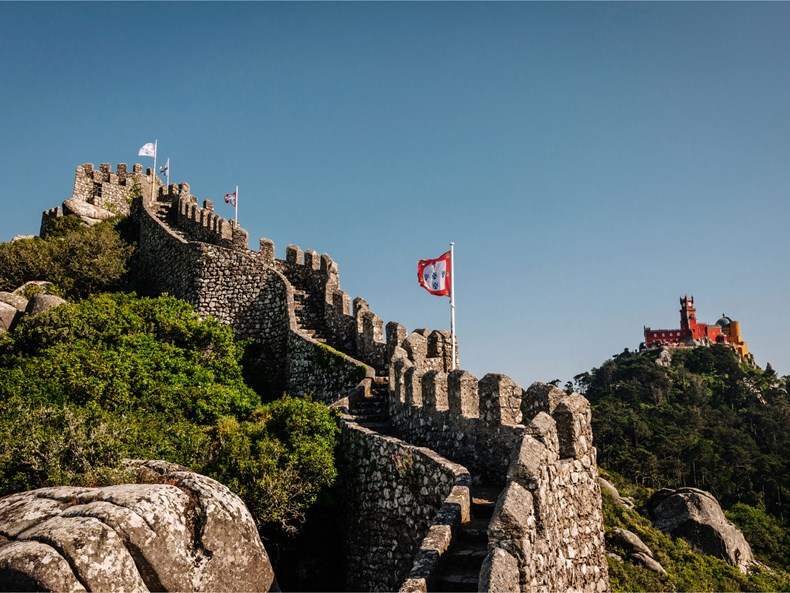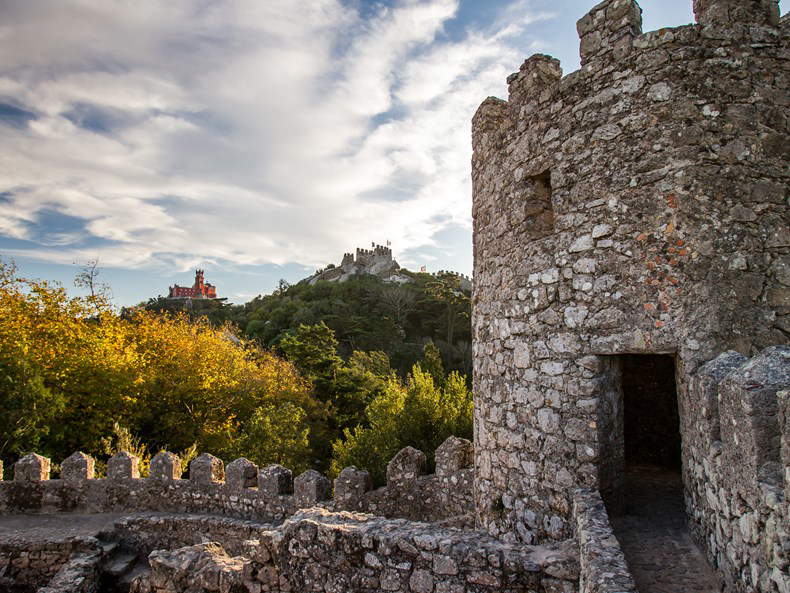In a dominant position on the hill overlooking the city of Sintra in Portugal from above, the Castle of the Moors (in Portuguese, Castelo dos Mouros) is an imposing fortification that dates back to the occupation of Portugal by the Moors: presumably built in the 8th century, it was finally conquered in 1147 by Afonso Henriques, the first king of Portugal, who had thirty inhabitants settle there for the purpose of protecting the fortress and the surrounding territory, in exchange for privileges. In 1375, under the reign of Ferdinand I, the castle was entirely rebuilt, but in the meantime its military importance had been diminishing, and the inhabitants, as a result, had moved from the castle to the village of Sintra. In the 15th century only the castle chapel appeared to be in use, but it too was abandoned in 1493, and only a small Jewish community remained in the Castle of the Moors: the ancient fortress remained completely uninhabited, however, and consequently abandoned, when Manuel I sanctioned the expulsion of the Jews from Portugal.
Further damaged by the Lisbon earthquake of 1755 and extensively in ruins in the 19th century, it surprisingly became the object of interest for Ferdinand II in 1840, who had it restored and rebuilt so that it could be admired from the Palacio da Pena, the pleasure residence of the Portuguese monarchs (the king was a great lover of art as well as ancient history): today, the Castelo dos Mouros is a popular tourist destination, not only because of its fascinating history, but also because it is located on the edge of the Sintra-Cascais Natural Park and is therefore an excellent starting point for nature walks, and it also offers splendid panoramic views of the city.
The Castle of the Moors follows an irregular perimeter of 450 meters on the crest of the hill, and consists of a double line of walls that wind through the middle of the vegetation. Because of its strategic location, during the time of Arab rule of the Iberian Peninsula, the castle was considered, along with Santarém, to be one of the mainstays of the defensive strategy of the Muslim province of Belata, corresponding roughly to today’s Ribatejo and Extremadura. Much of what can be seen today results from Ferdinand II’s rebuilding works.
 |
| The Castle of the Moors in Sintra. Photo Parques de Sintra |
 |
| The Castle of the Moors of Sintra. Photo Parques de Sintra |
 |
| The Castle of the Moors of Sintra. Photo Parques de Sintra |
 |
| The Castle of the Moors of Sintra. Photo Parques de Sintra |
 |
| The Castle of the Moors of Sintra. Photo Parques de Sintra |
 |
| The church of São Pedro de Canaferrim. Foto Parques de Sintra |
Points of interest that can still be seen today in the Castle of the Moors include the ancient silos that were used to store grain and cereals, the remains of the Islamic quarter, where the foundations of houses, warehouses and even an oven that served the entire community have been found (as well as numerous artifacts including pottery and utensils for daily life, such as pots, glasses, trays, bottles, pitchers, and so on), the church of São Pedro de Canaferrim, the ancient little church built in the 12th century shortly after Afonso Henriques conquered the castle (it is the oldest church in Sintra and was open for worship until the 14th century: today it stands as a small stone temple, extensively renovated by Ferdinand II, and has since become a small museum housing objects collected in the castle’s archaeological excavations). Then there is also the medieval Christian necropolis, which, as archaeological excavations have shown, was used for more than three hundred years, the ancient cavallerizze, or rooms that were believed to have served as stables for horses, the cistern that served as a water supply for the castle’s inhabitants, the parade ground, theAlcáçova, i.e., a small stronghold that constitutes one of the castle’s highest points, and the Torre Real, so called because it was one of Ferdinand II’s favorite places, who used to come here to contemplate the Palacio da Pena and the surrounding landscape.
The castle has been the constant subject of archaeological excavations since 1976: the research has led to numerous relevant discoveries about the history of the place and its inhabitants. In 1995, UNESCO listed Sintra as a World Heritage Site, and the Castle of the Moors thus became part of the list, being a fundamental element of the city’s cultural landscape. Today, the castle, a national monument, is managed by the Sintra Parks Authority, which has been following the castle’s fortunes since 2000: since that date, several restoration works have been carried out on the structure, and an Archaeological Research Camp was also created in 2009, to acquaint the public with the history of the castle, its construction phases and living spaces (partly transmitted to the public through the Documentation Center in the church of São Pedro de Canaferrim, which tells the story of the peoples who inhabited the castle, from the Neolithic to the Middle Ages, through archaeological finds and various interactive tools).
It is also one of Sintra’s most popular monuments, both by tourists and by the Portuguese, for whom the city, which lies just north of Lisbon, is a regular destination for out-of-town trips on holidays, and so the number of locals who like to spend a day at the castle is high, reasoning that booking a ticket in advance could prove crucial to avoid standing in line... !
 |
| The Castle of the Moors in Sintra, the ancient medieval fortress that dominates the Portuguese city |
Warning: the translation into English of the original Italian article was created using automatic tools. We undertake to review all articles, but we do not guarantee the total absence of inaccuracies in the translation due to the program. You can find the original by clicking on the ITA button. If you find any mistake,please contact us.